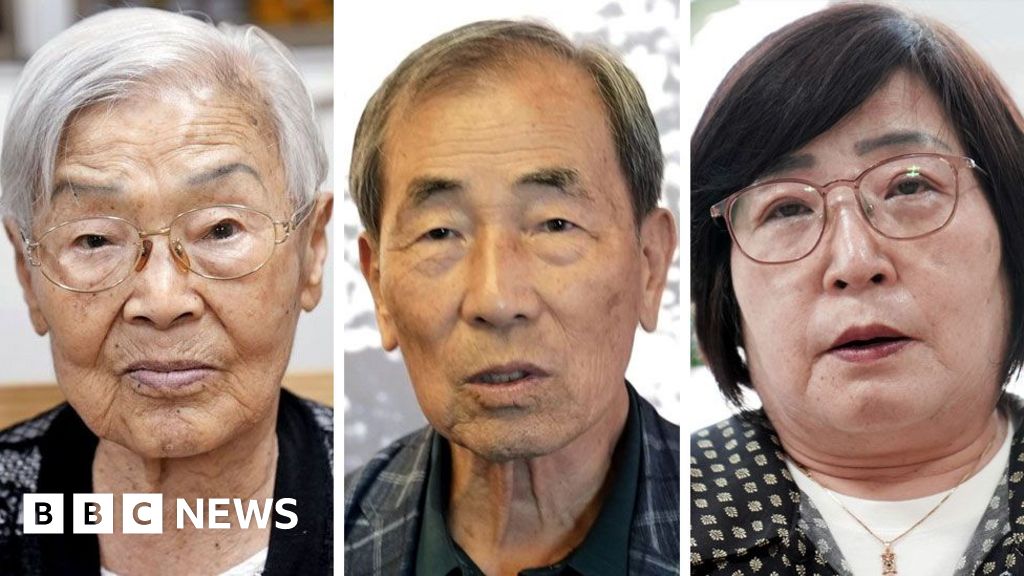生成中...【新闻趣读】"被原子弹炸伤两次"的韩国幸存者:广岛核爆时他们是日本殖民地的二等公民,回到祖国又因辐射伤痕沦为"被诅咒的人"。88岁的李贞顺至今记得1945年8月6日8:15——她上学路上看到"尸体融化得只剩眼睛",如今自己身患皮肤癌、帕金森和心绞痛,儿子还得了肾衰竭。最讽刺的是,这些韩国受害者等了80年,等来的却是美日韩三国的"踢皮球大赛":美国不道歉、日本装傻、韩国政府直到2019年才出调查报告!(友情提示:看完这条新闻,你会觉得广岛和平纪念馆里的千纸鹤格外刺眼)
---
Disfigured, shamed and forgotten: BBC visits the Korean survivors of the Hiroshima bomb
毁容、羞辱与遗忘:BBC探访广岛核爆韩国幸存者
1 day ago Share Save Hyojung Kim BBC Korean in Hapcheon Share Save
1天前 分享 保存 BBC韩国记者金孝贞在河川报道 分享 保存
BBC/Hyojung Kim Lee Jung-soon, 88, is one of many nuclear bomb survivors who now lives in Hapcheon, South Korea
BBC/金孝贞 88岁的李贞顺是现居韩国河川的众多核爆幸存者之一
At 08:15 on August 6, 1945, as a nuclear bomb was falling through the skies over Hiroshima, Lee Jung-soon was on her way to elementary school. The now-88-year-old waves her hands as if trying to push the memory away."My father was about to leave for work, but he suddenly came running back and told us to evacuate immediately," she recalls."They say the streets were filled with the dead – but I was so shocked all I remember is crying. I just cried and cried." Victims' bodies"melted away so only their eyes were visible", Ms Lee says, as a blast equivalent to 15,000 tons of TNT enveloped a city of 420,000 people. What remained in the aftermath were corpses too mangled to be identified."The atomic bomb… it's such a terrifying weapon." It's been 80 years since the United States detonated 'Little Boy', humanity's first-ever atomic bomb used against another nation, over the centre of Hiroshima, instantly killing some 70,000 people. Tens of thousands more would die in the coming months from radiation sickness, burns and dehydration. The devastation wrought by the bombings of Hiroshima and Nagasaki – which precipitated the end of both World War Two and Japanese imperial rule across large swaths of Asia – has been well-documented over the past eight decades. Less well-known is the fact that about 20% of the immediate victims were Koreans. Korea had been a Japanese colony for 35 years when the bomb was dropped. An estimated 140,000 Koreans were living in Hiroshima at the time - many having moved there due to forced labour mobilisation, or to survive under colonial exploitation. Those who survived the atom bomb, along with their descendants, continue to live in the long shadow of that day – wrestling with disfigurement, pain, and a decades-long fight for justice that remains unresolved.
1945年8月6日8时15分,当核弹划过广岛上空时,李贞顺正在去小学的路上。如今88岁的她挥手仿佛要驱散这段记忆。"父亲正要出门上班,却突然跑回来让我们立刻撤离,"她回忆道,"据说街上堆满尸体——但我当时吓傻了只记得哭。"李女士描述遇难者"身体融化得只剩眼睛可见",相当于1.5万吨TNT的爆炸吞噬了这座42万人口的城市,留下的只有无法辨认的残骸。"原子弹...真是可怕的武器。"80年前美国在广岛市中心投下人类史上首枚用于实战的原子弹"小男孩",当场造成约7万人死亡,随后数月又有数万人死于辐射病、烧伤和脱水。虽然广岛长崎的核爆加速二战结束和日本在亚洲殖民统治瓦解的破坏已被详尽记录,但鲜为人知的是约20%的直接受害者是朝鲜人。当时朝鲜已被日本殖民统治35年,估计有14万朝鲜人生活在广岛——许多是因强征劳工或殖民剥削被迫迁居。核爆幸存者及其后代至今仍活在阴影中,忍受毁容、病痛和长达数十年的未竟正义之争。
Getty Images Hapcheon has been dubbed"Korea's Hiroshima" due to the number of nuclear bomb survivors who lived there after the war
盖蒂图片社 因战后聚居大量核爆幸存者,河川被称为"韩国的广岛"
"No-one takes responsibility," says Shim Jin-tae, an 83-year-old survivor."Not the country that dropped the bomb. Not the country that failed to protect us. America never apologised. Japan pretends not to know. Korea is no better. They just pass the blame - and we're left alone." Mr Shim now lives in Hapcheon, South Korea: a small county which, having become the home of dozens of survivors like he and Ms Lee, has been dubbed"Korea's Hiroshima". For Ms Lee, the shock of that day has not faded - it etched itself into her body as illness. She now lives with skin cancer, Parkinson's disease, and angina, a condition stemming from poor blood flow to the heart, which typically manifests as chest pain. But what weighs more heavily is that the pain didn't stop with her. Her son Ho-chang, who supports her, was diagnosed with kidney failure and is undergoing dialysis while awaiting a transplant."I believe it's due to radiation exposure, but who can prove it?" Ho-chang Lee says."It's hard to verify scientifically - you'd need genetic testing, which is exhausting and expensive." The Ministry of Health and Welfare (MOHW) told the BBC that it had gathered genetic data between 2020 and 2024 and would continue further studies until 2029. It would"consider expanding the definition of victims" to second- and- third-generation survivors only"if the results are statistically significant", it said.
"没人承担责任,"83岁的幸存者沈晋泰说,"投弹的国家不负责,没能保护我们的国家也不负责。美国从不道歉,日本装不知道,韩国也好不到哪去。他们互相推诿——只剩我们独自承受。"沈先生现居韩国河川郡,这个聚居着数十位像他和李女士这样幸存者的小城被称为"韩国的广岛"。对李女士而言,那天的冲击从未消退——它化作疾病刻进身体。她现在患有皮肤癌、帕金森和心绞痛,而痛苦并未止步——照顾她的儿子李浩章被诊断肾衰竭,正在透析等待移植。"我相信是辐射导致的,但谁能证明?"李浩章说,"科学验证太难了——需要基因检测,既耗神又昂贵。"韩国保健福祉部向BBC表示2020至2024年已收集基因数据,将持续研究至2029年,称"若统计结果显著"会"考虑将受害者定义扩展至二三代幸存者"。
The Korean toll
朝鲜人的伤亡
Of the 140,000 Koreans in Hiroshima at the time of the bombing, many were from Hapcheon. Surrounded by mountains with little farmland, it was a difficult place to live. Crops were seized by the Japanese occupiers, droughts ravaged the land, and thousands of people left the rural country for Japan during the war. Some were forcibly conscripted; others were lured by the promise that"you could eat three meals a day and send your kids to school." But in Japan, Koreans were second-class citizens – often given the hardest, dirtiest and most dangerous jobs. Mr Shim says his father worked in a munitions factory as a forced labourer, while his mother hammered nails into wooden ammunition crates. In the aftermath of the bomb, this distribution of labour translated into dangerous and often fatal work for Koreans in Hiroshima.
当时广岛的14万朝鲜人中许多来自河川。这个群山环绕、耕地稀少的地区生存艰难。日本占领者强征粮食,旱灾肆虐,成千上万人战时赴日谋生。有些是被强征,有些则被"一日三餐、子女上学"的承诺诱骗。但在日本,朝鲜人是二等公民——总被分配最艰苦肮脏危险的工作。沈先生说他父亲在军工厂当苦力,母亲给弹药箱钉木板。核爆后,这种劳力分配让朝鲜人承担了更多危险致命的工作。
BBC/Hyojung Kim For Shim Jin-tae, it's not just about being compensated – it's about being acknowledged
BBC/金孝贞 对沈晋泰而言,赔偿远不如被承认重要
"Korean workers had to clean up the dead," Mr Shim, who is the director of the Hapcheon branch of the Korean Atomic Bomb Victims Association, tells BBC Korean."At first they used stretchers, but there were too many bodies. Eventually, they used dustpans to gather corpses and burned them in schoolyards."It was mostly Koreans who did this. Most of the post-war clean-up and munitions work was done by us." According to a study by the Gyeonggi Welfare Foundation, some survivors were forced to clear rubble and recover bodies. While Japanese evacuees fled to relatives, Koreans without local ties remained in the city, exposed to the radioactive fallout – and with limited access to medical care. A combination of these conditions - poor treatment, hazardous work and structural discrimination - all contributed to a disproportionately high death toll among Koreans. According to the Korean Atomic Bomb Victims Association, the Korean fatality rate was 57.1%, compared to the overall rate of about 33.7%. About 70,000 Koreans were exposed to the bomb. By year's end, some 40,000 had died.
"朝鲜工人不得不清理尸体,"韩国原子弹受害者协会河川分会会长沈先生告诉BBC韩语频道。"起初用担架,但尸体太多。最后用簸箕收尸在学校操场焚烧。""干这活的多是朝鲜人。大部分战后清理和军火工作都是我们做的。"京畿福利基金会研究显示,一些幸存者被迫清理瓦砾收尸。当日本疏散者投奔亲友时,无依无靠的朝鲜人留在城里暴露于放射性尘埃——且医疗资源匮乏。这些因素——恶劣待遇、危险工作和制度歧视——共同导致朝鲜人死亡率畸高。据韩国原子弹受害者协会数据,朝鲜人死亡率57.1%,远高于整体约33.7%。约7万朝鲜人暴露于核爆,到年底4万人死亡。
Outcasts at home
故土的弃儿
After the bombings, which led to Japan's surrender and Korea's subsequent liberation, about 23,000 Korean survivors returned home. But they were not welcomed. Branded as disfigured or cursed, they faced prejudice even in their homeland."Hapcheon already had a leper colony," Mr Shim explains."And because of that image, people thought the bomb survivors had skin diseases too." Such stigma made survivors stay silent about their plight, he adds, suggesting that"survival came before pride". Ms Lee says she saw this"with her own eyes"."People who were badly burned or extremely poor were treated terribly," she recalls."In our village, some people had their backs and faces so badly scarred that only their eyes were visible. They were rejected from marriage and shunned." With stigma came poverty, and hardship. Then came illnesses with no clear cause: skin diseases, heart conditions, kidney failure, cancer. The symptoms were everywhere - but no-one could explain them. Over time, the focus shifted to the second and third generations.
核爆导致日本投降和朝鲜解放后,约2.3万朝鲜幸存者返乡。但他们不受欢迎。即使在家乡也被视为毁容或被诅咒的人。"河川已有麻风病人聚居区,"沈先生解释,"因此人们以为核爆幸存者也患皮肤病。"这种污名让幸存者缄默,"生存重于尊严"。李女士说她"亲眼所见":"严重烧伤或极度贫困者遭受恶劣对待,"她回忆,"村里有些人背部和脸部严重疤痕只露眼睛。他们被拒婚和躲避。"污名伴随贫困艰难。接着是无法解释的疾病:皮肤病、心脏病、肾衰竭、癌症。症状无处不在却无人能解。渐渐地焦点转向二三代。
BBC/Hyojung Kim Second-generation survivor Han Jeong-sun can't walk without dragging herself, and has faced stigma from her own family
BBC/金孝贞 二代幸存者韩正顺无法正常行走,甚至遭家人歧视
Han Jeong-sun, a second-generation survivor, suffers from avascular necrosis in her hips, and can't walk without dragging herself. Her first son was born with cerebral palsy."My son has never walked a single step in his life," she says."And my in-laws treated me horribly. They said, 'You gave birth to a crippled child and you're crippled too—are you here to ruin our family?'"That time was absolute hell." For decades, not even the Korean government took active interest in its own victims, as a war with the North and economic struggles were treated as higher priorities. It wasn't until 2019 - more than 70 years after the bombing - that MOHW released its first fact-finding report. That survey was mostly based on questionnaires. In response to BBC inquiries, the ministry explained that prior to 2019,"There was no legal basis for funding or official investigations". But two separate studies had found that second-generation victims were more vulnerable to illness. One, from 2005, showed that second-generation victims were far more likely than the general population to suffer depression, heart disease and anaemia, while another from 2013 found their disability registration rate was nearly double the national average. Against this backdrop, Ms Han is incredulous that authorities keep asking for proof to recognise her and her son as victims of Hiroshima."My illness is the proof. My son's disability is the proof. This pain passes down generations, and it's visible," she says."But they won't recognise it. So what are we supposed to do - just die without ever being acknowledged?"
二代幸存者韩正顺患髋关节缺血性坏死,只能拖行。长子患脑瘫。"我儿子一生没走过一步,"她说,"婆家待我极差。他们说'你生个残废自己也是残废——是来毁我们家的吗?''那段时间简直是地狱。'"数十年来韩国政府都未积极关注这些受害者,优先应对朝鲜战争和经济困难。直到2019年——核爆70多年后——保健福祉部才发布首份调查报告,主要基于问卷。该部向BBC解释2019年前"缺乏资助或官方调查的法律依据"。但两项独立研究发现二代更易患病。2005年研究显示二代患抑郁、心脏病和贫血概率远高于常人,2013年研究发现其残疾登记率近全国均值两倍。在此背景下,韩女士难以相信当局还要求证明她和儿子是广岛受害者。"我的病就是证明。我儿子的残疾就是证明。这种痛苦代代相传且肉眼可见,"她说,"但他们不承认。我们该怎么办——到死都得不到承认?"
Peace without apology
无道歉的和平
It was only last month, on 12 July, that Hiroshima officials visited Hapcheon for the first time to lay flowers at a memorial. While former PM Yukio Hatoyama and other private figures had come before, this was the first official visit by current Japanese officials."Now in 2025 Japan talks about peace. But peace without apology is meaningless," says Junko Ichiba, a long-time Japanese和平活动家大半生为韩国广岛受害者奔走。她指出来访官员只字未提日本在二战前后对朝鲜人的所作所为。
BBC/Hyojung Kim A memorial hall in Hapcheon holds 1,160 wooden tablets - each one bearing the name of a Korean killed by the nuclear bomb
BBC/金孝贞 河川纪念馆陈列1160块木牌——每块刻着一名朝鲜核爆死难者姓名
The memorial hall in Hapcheon displays 1,160 wooden tablets inscribed with names of Korean victims - just a fraction of the total death toll."These people were erased twice," says curator Park Ji-young."First by the bomb, then by history." For survivors like Ms Lee, the struggle continues."We don't want pity," she says."We want the world to remember what happened to us - and to make sure it never happens to anyone else."
河川纪念馆展出的1160块名牌仅是死亡总数的一小部分。"这些人被抹杀了两次,"馆长朴志英说,"先被核弹,后被历史。"对李女士这样的幸存者,抗争仍在继续。"我们不要怜悯,"她说,"我们要世界记住我们的遭遇——并确保不再重演。"
With additional reporting by Tiffanie Turnbull in Tokyo
东京记者蒂芙妮·特恩布尔补充报道

